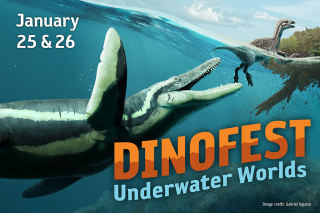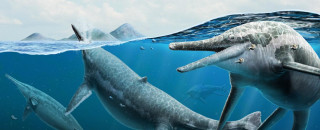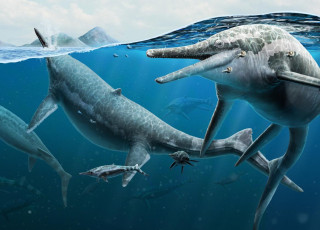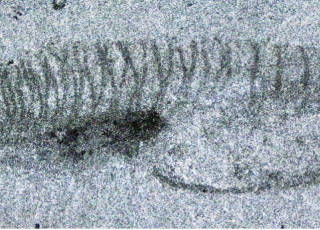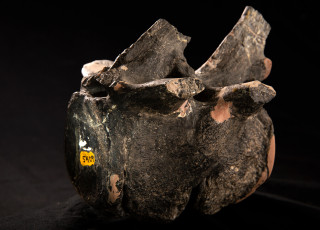Dinosaur Surf or Turf: Unpacking Mesozoic Misconceptions
This article was published in advance of DinoFest, an event which took place at NHMU on January 25 and 26, 2025. The event explored ancient underwater worlds and marine reptiles.
By Jude Coleman
Dinosaurs have become more or less synonymous with massive, ancient reptiles. But did you know that name only applies to certain reptiles living on land? Despite sharing the world with dinosaurs, the water-dwellers of the Mesozoic Era — like the ancestors of today’s crocodiles and turtles — were not true dinosaurs.
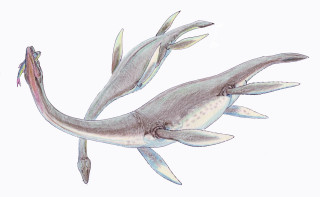
Plesiosaurus dolichodeirus via Creative Commons.
Image by Dmitry Bogdanov
Although some dinosaurs lived near the shores of lakes, rivers, and oceans and sometimes went for a swim, there were none that lived underwater. Animals that did live underwater are collectively called marine reptiles. “Just because they're big and ancient and extinct doesn't mean they're dinosaurs,” said Randy Irmis, the Natural History Museum of Utah’s Curator of Paleontology. And while dinosaurs are one distinct type of reptile, Irmis emphasized that marine reptiles represent many different types of reptiles, which all evolved to live in water independently. In fact, they “entered” the water at different times throughout the Mesozoic. For example, the ancestors of plesiosaurs, a long necked, four-flippered giant, evolved to live in water in the Early Triassic Period around 250 million years ago. Several lineages of turtles became aquatic throughout the Triassic, Jurassic, and Cretaceous. The biggest tell between dinosaurs and marine reptiles, Irmis said, is that dinosaurs have a hole in their hip sockets, whereas all other reptiles have only a depression.
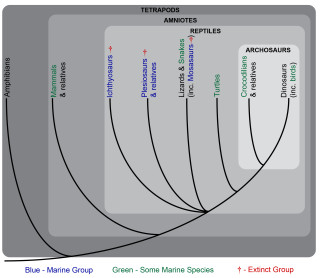
Evolutionary family tree showing the relationships of various marine reptile groups. Graphic © NHMU.
Some marine reptiles, such as plesiosaurs and ichthyosaurs, aren’t closely related to any living reptiles today. But others are the ancestors of modern-day animals — ancient relatives of crocodiles, snakes, and turtles, for instance, all roamed the planet over 200 million years ago. And just like the reptiles of today, those aquatic animals could be semi-aquatic or fully aquatic. Fully aquatic reptiles spent their whole life in the water, with bodies that were not adapted to spend any significant time on land. Semi-aquatic reptiles got the best of both worlds, with anatomy that allowed them to swim through water and stroll along the shore. Because their features weren’t specialized for one habit or the other, that can make it difficult for paleontologists to distinguish where a reptile spent most of its time. “Semi-aquatic reptiles could easily, just as happily, spend most of their time on land, and we wouldn't know it from their skeleton,” Irmis said.
Did Dinosaurs and Marine Reptiles Ever Interact?
Just because dinosaurs were land dwellers doesn’t mean they didn’t have business in the water. Scientists have identified special fossils called swim tracks that prove dinosaurs took watery voyages. Swim tracks are distinct drag marks that were preserved in the soft sediment of shallow water bodies. They formed when the toes of a floating dinosaur touched the bottom while swimming. “The water [was] just shallow enough that their toes touched the bottom,” Irmis said.
While in or near the water, some dinosaurs preyed on fish and other aquatic animals. Paleontologists have found fossilized dinosaur poop with fish scales in it, and have evidence of some species with teeth specialized for this type of prey. Likewise, Irmis said aquatic reptiles probably made a snack out of some dinosaurs if the chance arose. “If a small dinosaur was wading in the shallows, and one of these larger marine reptiles was looking for lunch, I'm sure they would go after it.” Crocodiles certainly did: some dinosaur fossils have distinct crocodile tooth marks on their bones.
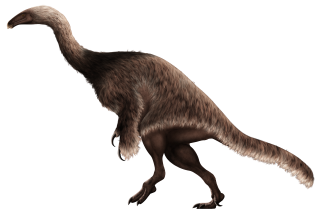
Nothronychus graffami via Creative Commons. Image by PaleoNeolitic
Mysteriously, researchers have found a few dinosaur fossils preserved in seafloor sediments deposited miles from the coast. But they didn’t get there from living and dying in the sea. Instead of dying in the ocean, these animals died next to it, on the coast. Then, as the body decayed, it became bloated — and buoyant. That made it easier for the tide and currents to sweep the carcass away out to sea, where it eventually sunk to the sea floor after the decomposition gasses were released. A good example of this type of dinosaur fossil is Utah’s Nothronychus graffami, which you can see in the NHMU's Past Worlds exhibit.
The Only Aquatic Dinosaur
Although marine reptiles weren’t dinosaurs, there are technically aquatic dinosaurs during the Cretaceous Period through today: birds. “Birds are small, carnivorous dinosaurs that evolved to fly,” Irmis said. Just like turtles, birds have evolved several times throughout history to live on the water. That means there are hundreds of species of living aquatic dinosaurs today, such as penguins, ducks, and cormorants.
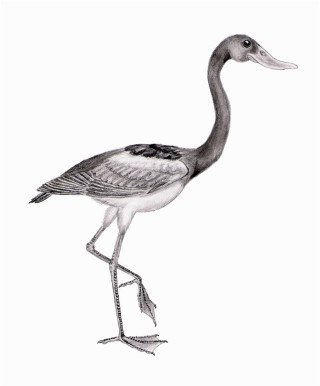
Presbyornis via Creative Commons. Image by Smokeybjb
Birds have a long evolutionary history, much of which is preserved in the fossil record, Irmis said. Because of that, scientists have been able to tease out relationships between ancient birds and modern ones: Penguins have their ancestral roots as far back as the end of the Cretaceous Period; an aquatic ancestor of ducks and geese, Presbyornis, was a resident of Utah, Colorado, and Wyoming during the early Eocene Epoch. Museum visitors can see Presbyornis on display in the Past Worlds exhibit, along with many other fossils featured only during NHMU's annual DinoFest. The Late Cretaceous Western Interior Seaway of North America was home to several marine birds that have no close living relatives, including Hesperornis, one of the first fossil birds with teeth to be discovered. DinoFest keynote speaker Dr. Laura Wilson is a world expert on Hesperornis and its relatives.
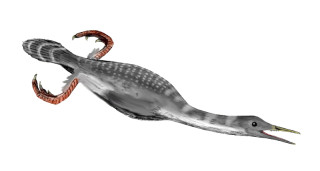
Hesperornis via Creative Commons. Image © N. Tamura
This detailed fossil record provides lots of evidence allowing paleontologists to conclude that birds are dinosaurs. Around 165 million years ago, the first flying species evolved from their theropod ancestors. Theropods are the group that includes the two-legged meat-eating dinosaur, and within this group, birds share a close common ancestry with the sickle-clawed dinosaurs such as Velociraptor. The animals also shrank considerably. Today's birds still share many anatomical features with their non-flying dinosaur relatives, such as holey hip sockets and a bone called the furcula. You may know it better as the wishbone: a V-shaped bone in birds’ chest, often snapped on Thanksgiving. “It's only found in birds and meat-eating dinosaurs, and so it's a great example of evidence that birds are meat-eating dinosaurs,” Irmis said.
So the next time you think of ancient aquatic animals, remember that many were marine reptiles, not dinosaurs. And the next time you see a duck, remember that you’re looking at a tiny, modern dino.
DinoFest
If you enjoyed this article, then be sure to check out DinoFest at NHMU on January 25 and 26, 2025, where we will be exploring ancient underwater worlds and marine reptiles.
